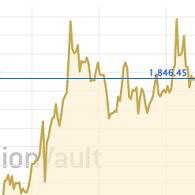London
A government defaults on its AAA rated stock
Tax-collecting difficulties
After England's brief flirtation with a republic Charles II was restored to the throne in 1660, but some of the royal powers his father had enjoyed were now shared with a representative parliament.
In particular the royal tax-raising privilege had been lost, leaving him forever begging taxes from his new governing partners. The process was slow because parliament met rarely and because the logistics of collection were complicated, so Charles was struggling to pay the bills.
Help from bankers
At about this time the financial development of London was getting underway. The goldsmiths - whose traditional role was the fabrication of jewellery and plate - were emerging from a number of potential candidates as the trade group which would evolve into modern bankers. Their success grew from the safekeeping role of their vaults through the uncertain period of the English civil war, and also from the strength of London's position within growing European trade, with its frequent requirement to exchange foreign coin.
They soon found themselves able to lend as well, and from this they became the middlemen in a developing market in government debt.
It worked like this: armed with parliamentary permission to raise taxes Charles immediately cashed in by selling specific future tax receipts to the gold-rich goldsmiths, at a discount to the face value of the tax. To begin with the goldsmiths were unable to distribute the royal debt, and were soon incapable of lending the king more. So it was arranged that the debt redemption would in fact be paid not to the original goldsmith-lender, but to any bearer of the debt, thereby enabling the goldsmith to sell the debt on and replenish his cash, ready for the next royal loan.
The next problem was how to ensure the new bearer - not being the original lender - could reliably identify the authenticity of the debt. And here nature offered an ancient solution.
Notched wooden sticks
A piece of wood split down the middle will only match perfectly with its other half. So wooden sticks called tallies became a key component of English money supply. The government's debt office took a nice looking hazel stick and notched across it various symbols which denoted monetary amounts borrowed and lent. The stick was then split down the middle, with each side showing one end of the notches. One side - which had a wooden handle known as a 'stock' - was held by the king's treasury, while the other was given to the goldsmith.

A wooden 'tally' stick
The system was simple and effective and the the goldsmith-bankers proved trustworthy. They generated liquidity by trading what were by now being called 'stocks' between themselves, and they solemnly placed all the wooden sticks in their own vaults, next to their diminishing pile of gold and silver. They had good reason to remain honest as they were well placed in a profitable and rapidly growing market. For their part the wooden sticks thoroughly outwitted the forgers, and the king was the ultimate and trusted guarantor of all the debts.
Problems caused by success
Far from absurdity it was the perfection of the system which ultimately caused its downfall, because it led to a market far bigger than was ever healthy. To begin with the supply of cash came from the goldsmith bankers themselves. Then, with caution, they let out a little of the money they held on private current accounts, knowing that their own personal credit would get them sufficient cash if ever they needed it to repay their depositors in a hurry. Then they realised they could do better still by offering interest on private accounts held at notice, because the notice period would eliminate sudden cash calls. By paying interest they accumulated more public cash, and these funds were lent on to the king at an increasing rate.
Charles soon found he no longer needed to bother with parliamentary approval to raise taxes before issuing stock, because, like any modern day AAA issuer, he could sell it anyway, and from about 1668 it became generally accepted that the state's borrowings were secured by unspecified future taxes on the nation; an assumption which remains with us today.
The parliamentary brake on the speed of issue of this new monetary medium had now been sidestepped, and before long half of London was booming on credit evidenced by valuable broken wooden sticks. This was when things started to get harder.
The market demands a rate rise
As each tier of willing private depositors dried up it took another notch up the interest rate scale to squeeze out more of the public's cash. The goldsmiths could only offer to the king discounts which they could finance by attracting deposits, and by 1670 the king was having to accept as much as 10% per annum discount on the face of his 'stock' debts. Depositors were by now receiving 7% and the middlemen the rest.
By 1671 the system was hardly benefiting the king at all because redemptions were consuming all the cash subsequent issues could raise. He had sucked in all the private money he was going to get, so when at the year's end he demanded still more vital cash for his navy the bankers couldn't get it - at any price.
Default
Annoyed, Charles conveniently remembered that the bulk of the loans which he had recently taken out had been at rates above the 6% limit permitted by his own usury laws. He declared the debts illegal and his own exchequer's payments stopped. This temporary action was enacted on 2nd January 1672, was extended after one year for another two, and after those two (subject to a few carefully chosen exceptions) it became indefinite.
The effect - often repeated since - was that those who lent to the state, and accepted a substitute deemed 'good as gold' in its place, turned out to have accidentally provided all their carefully accumulated personal wealth as voluntary taxes. The goldsmiths were blamed. They were caricatured as greedy opportunists and damned by their once enthusiastic depositors. Eleven of the biggest fourteen failed, leaving their chiefs variously (i) ruined, (ii) bankrupted (iii) on the run (iv) jailed or (v) dead.
The humble wooden stick never regained any serious credibility and lost out to a close cousin - paper.
You can visit the official government site of the USA's public debt (http://www.publicdebt.treas.gov/opd/opdpenny.htm).









 Email us
Email us